

According to the concept of Operant Conditioning, Reinforcement and Punishments can be used to influence the behaviour of teenage children. Tips are given in the articles below to teach parents how to use it effectively to get positive outcomes.
Reinforcement, even when it is negative, always increases a behaviour. In contrast, punishment tend to decrease a behaviour (Zimbardo, Johnson, & Hamilton, 2014). There are four main methods that parents can apply to decrease the frequency of a child’s negative behaviours and encourage positive behaviours in their daily lives:
- Positive Punishment
- Positive Reinforcement
- Negative Punishment
- Negative Reinforcement.
How to Properly Use Reinforcement and Punishment - North Shore Pediatric Therapy. Reinforcement and punishment are common terms that most people have heard of and use on a daily basis, whether they realize it or not.

Although the concepts seem easy to understand and implement, it can be easy to confuse the basic principles and/or implement them incorrectly. In order to understand the difference between reinforcement and punishment, it is important to understand the definitions of both terms. Reinforcement Reinforcement is a consequence following a behavior that increases the probability that the behavior will increase in the future. The consequence can be either positive or negative. Positive Reinforcement is something added to the consequence that will increase that particular behavior in the future.
Example: Your child cleans his room the first time you ask, so you give him a cookie as a reward. Negative Reinforcement is something removed from the consequence that will increase that particular behavior in the future. Reinforcement vs. Punishment: Changing BehaviorBehavioral Health Works. Being a parent has been known as the best thing ever BUT also the most challenging endeavor you will encounter in your lifetime.
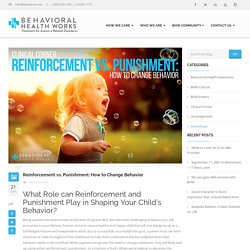
Parents strive to raise a healthy and happy child that will one day grow up as a full-fledged mature and independent adult. But to successfully accomplish this goal, a parent must set forth structure or rules throughout their childhood to help them understand and be realigned when their behavior needs to be modified. When a parent recognizes the need to change a behavior, they will likely end up using either reinforcement, punishment, or a mixture of both. When we’re helping to decrease the frequency of a child’s negative behavior, having the reinforcement or punishment methods in our toolkit can help you modify and implement the desired behavior.
What is Positive Punishment? What Is 'positive Punishment'? Definition And Real-World Examples. Positive Punishment: What Is It And How It Works? - MomJunction. Image: Shutterstock Positive punishment!
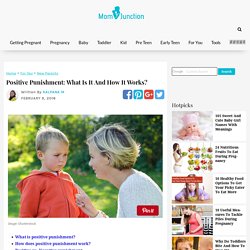
Sounds like a perfect oxymoron. What Is 'negative Punishment'? Definition And Real-World Examples. Negative punishment is a popular concept in parenting.
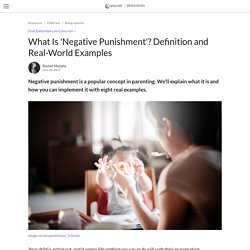
We'll explain what it is and how you can implement it with eight real examples. Your child is acting out, and it seems like nothing you say or do will curb their exasperating behavior. Sound familiar? No matter whether you're a parent, a babysitter, a nanny, or a day care worker, we’ve all been there -- scratching our heads, desperately racking our brains for the right solution to get our children to play nice.
And with so many different parenting techniques out there, it's hard to figure out which one will work best for your child. Negative punishment could be one way to address this issue. This parenting technique, when used correctly, can be an effective tool that alters your child’s conduct for the better. How Negative Punishment Works. Negative punishment is an important concept in B.
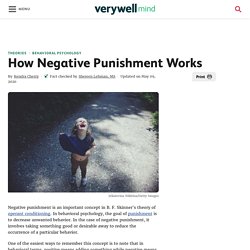
F. Skinner's theory of operant conditioning. In behavioral psychology, the goal of punishment is to decrease unwanted behavior. In the case of negative punishment, it involves taking something good or desirable away to reduce the occurrence of a particular behavior. Positive Reinforcement - Tips for teaching and parenting. How to Use Positive Reinforcement to Improve Your Child's Behavior.
When your child misbehaves, rewards might be the last thing on your mind.
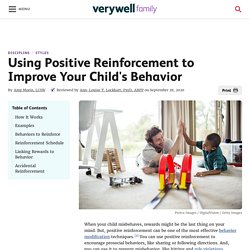
But, positive reinforcement can be one of the most effective behavior modification techniques.1 You can use positive reinforcement to encourage prosocial behaviors, like sharing or following directions. And, you can use it to prevent misbehavior, like hitting and rule violations. What Are the Benefits of Positive Reinforcement in Kids? Reinforcing good behavior while discouraging disobedience and anti-social behavior generally produces positive results in children.
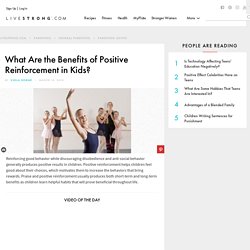
Positive reinforcement helps children feel good about their choices, which motivates them to increase the behaviors that bring rewards. Praise and positive reinforcement usually produces both short-term and long-term benefits as children learn helpful habits that will prove beneficial throughout life. Discipline involves teaching and instructing children. While some people use punitive measures or the removal of privileges, positive reinforcement might have fewer long-term consequences and more life-long benefits. What is Negative Reinforcement? What Is 'negative Reinforcement'? Definition And Real-World Examples. Tips on the Misuses of Negative Reinforcement for Parents. So often, parents become frustrated with their little ones as the twists and turns of toddler logic throw adults for a loop.

The "because I said so" that seemed so unfair to us just years ago is now the only response that doesn't start a bartering session. Some parents reach for negative reinforcement, when positive reinforcement doesn't seem to be enough. Negative reinforcement is when a parent rewards a child for good behavior by taking away an aversion in his daily life. For instance, if a preschooler picks up all the cereal he spilled on the floor, she doesn't have to help mom clean the bathroom. Accidental Use Much of the time, negative reinforcement happens accidentally. Denying Basic Comforts Parents are responsible for the well-being of their kids, and part of that means creating an environment in which there aren't many discomforts to avoid. Bullying Too much negative reinforcement can come across as bullying.
Low Self Esteem. Why Positive Reinforcement is Better than Punishment - Clever Little Monkey. Psychologists often encourage parents to adopt strategies of classic behaviour modification to alter their children’s challenging, naughty behaviours instead of using positive reinforcement techniques.

The theory is that the immediate consequence that you receive after performing an action makes you more or less likely to repeat the action in future. Punishment vs reinforcement: Getting the behavior you want from your kids.